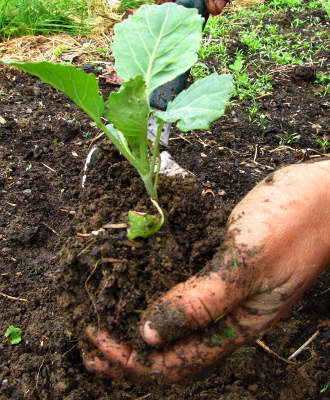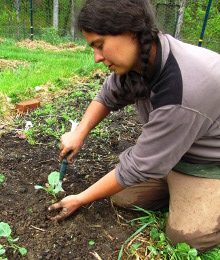
Rainy day transplanting
 Some damp days, we rearrange
our calendars and focus on indoors work. But other times, we take
advantage of the wet.
Some damp days, we rearrange
our calendars and focus on indoors work. But other times, we take
advantage of the wet.

Wednesday was one of
those happy-to-be-wet days. I needed to move some Swiss chard,
broccoli, and cabbage seedlings around to even out the spacing, and a
drippy day promised to minimize the transplant shock. Not only
did I not have to water in the rearranged seedlings, the cloud cover
meant they got a day of rest before having to deal with bright sunlight.
Don't try this at home,
though, unless you're willing to get soaked and covered in dirt from
the waist down.
Want more in-depth information? Browse through our books.
Or explore more posts by date or by subject.
About us: Anna Hess and Mark Hamilton spent over a decade living self-sufficiently in the mountains of Virginia before moving north to start over from scratch in the foothills of Ohio. They've experimented with permaculture, no-till gardening, trailersteading, home-based microbusinesses and much more, writing about their adventures in both blogs and books.
Want to be notified when new comments are posted on this page? Click on the RSS button after you add a comment to subscribe to the comment feed, or simply check the box beside "email replies to me" while writing your comment.

Yeah for the rain!
When you transplant/disrupt wet soil are you worried about damaging the soil structure?
MamaHomesteader --- Our tomato sets are enjoying hardening off outdoors today too. I'm itching to put them in the ground, but am waiting until after the potential frosts Sunday and Monday.
Emily --- Excellent question. With my minimal method of transplanting, you don't need to worry much about disrupting soil structure. I just hand weed, pull back the earth to make a shallow depression, and pack the dirt back in around the seedling. I think it probably actually causes less soil structure damage than the more traditional method of transplanting into dry soil, but watering heavily.
I keep meaning to write a long post about how no-till gardens let you play outdoors even when the ground is wet. But I'll save that for another day!